#Sleeveless Tube Top And Pleated Skirt Mid-length Dress Set
Explore tagged Tumblr posts
Text
#women#woman#trendy#trend#style#Sleeveless Tube Top And Pleated Skirt Mid-length Dress Set#fashionable#fashion
2 notes
·
View notes
Text
Abridged history of early 20th century Chinese womenswear (part 3.1: 1920s-silhouette)

Source: lucianolapadula.wordpress.com
*Disclaimer: I mostly talk out of my bum so don’t ask me for academic sources, I would love to know where they are but I haven’t found any reliable ones. I only share my own observations so please read me for filth if I’m wrong.
*There are almost no public domain images I could use because this topic is too obscure so I have to use random images that work and link the sources.
Intro/Context
In the 1920s the dominant form of womenswear was still technically the aoqun, however one piece dresses, sometimes with a fake vest, became popularized later in the decade and that could be considered a kind of proto-cheongsam. Many scholars and people on the Internet have different theories as to which particular garment was the true predecessor to the cheongsam but I think that’s a pointless quest, everything went in 1920s fashion and many styles bearing the same silhouette coexisted and they were all valid, it’s just that the one piece dress emerged victorious in the 1930s as the dominant form of womenswear. Looking at 1920s fashion with the sole purpose of finding the origins of cheongsam doesn’t do the decade justice.
In the 1920s Western influence also became more visible and many Art Deco designs were integrated into Chinese fashion, making it an all round exciting and creative decade for Chinese fashion.
Silhouette
In the early 1920s, the hem of the robe was similar to the mid-1910s ao from my previous post, hitting about the top of the hips. The sleeves became somewhat wider, but not reaching the widest point until the mid 20s. The skirt became shorter, usually mid calf, and was not as full as the pleated skirt of the previous decade. I was not able to find a lot of information about early 20s fashion but from the few contemporary drawings I did find (such as the one below) the outer robe of the previous decade seem to have become sleeveless in some occasions, resembling more of a vest, exposing the sleeves of the undershirt. Put a pin in this as the vest style will become quite prominent later in the decade.
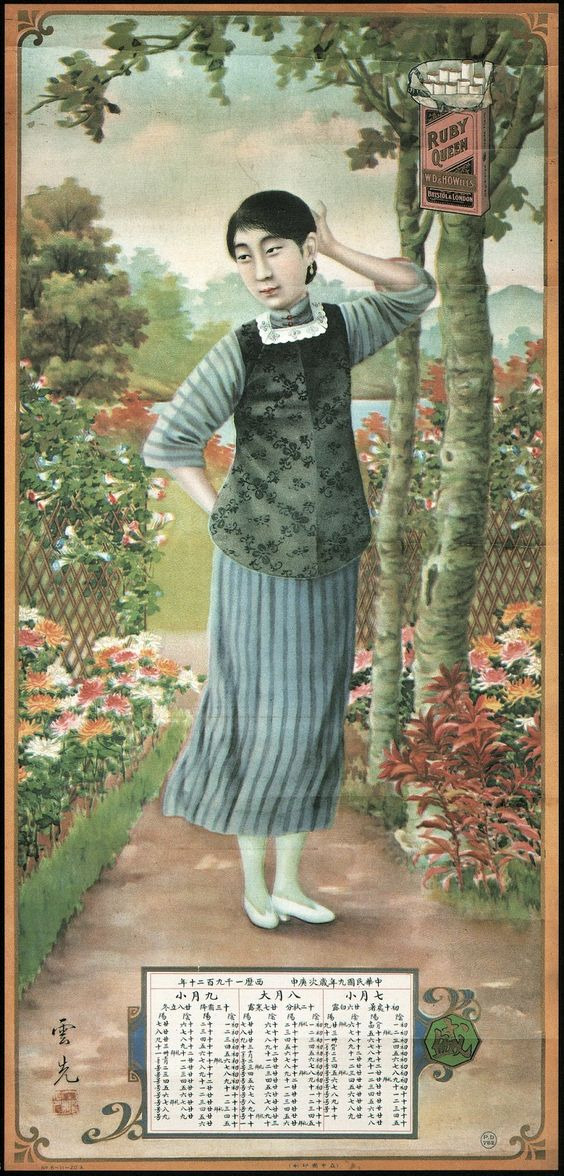
Source: https://historypipe.blogspot.com/ (a cigarette ad from 1920)
Aoku (robe with pants) was still considered a fashionable way of dressing in the early 20s, then it started to fade out of popularity. The pants of the early 1920s were shorter and less form fitting than those in the 1910s, usually ending below the knee, allowing stockings to show, which could be very colorful and elaborate.

Source: lai yiching0926 on Pinterest https://www.pinterest.de/pin/675540012850646515/ (a tea ad from 1920)
Around the mid 1920s the skirt began to shorten, eventually reaching knee length, a development similar to that in Western fashion at the time. Pleating became fashionable again; instead of the mamian style pleating with flat sections in the front and back popular in previous decades, mid to late 20s skirts were completely pleated along the waistline, giving them an all round even fullness. Mid to late 1920s skirts commonly had wide hems, which could be decorated with embroidery, trimmings, scallop edges or other Western finishes. The sleeves were half length or shorter and became wider at the bottom, a style commonly known as 倒大袖.

Source: lai yiching0926 on Pinterest https://www.pinterest.de/pin/675540012850651575/ (a calendar showing the years 1926-1927) (the lady to the left is wearing aoku and the other aoqun. Notice the vest look)
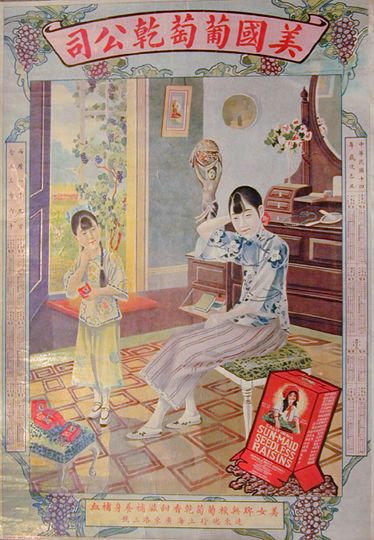
Source: http://robertbrowngallery.com/artists_exhibited/artist_pages/image_page.php?image=Chinese_Advertising_Posters- (a raisin ad from 1925-26)
Around the same time, the proto-cheongsam one piece dress look was also being popularized. In the mid 1920s this style was usually knee length, with short sleeves and a high collar; they could also have the fake two piece effect, giving the appearance of a separate vest/tunic being worn. These dresses could have flared hems or short slits down both sides to allow freedom of movement. Interestingly, these dresses were tighter and more body-hugging than Western women’s dresses at the time, which were baggy and rectangular.
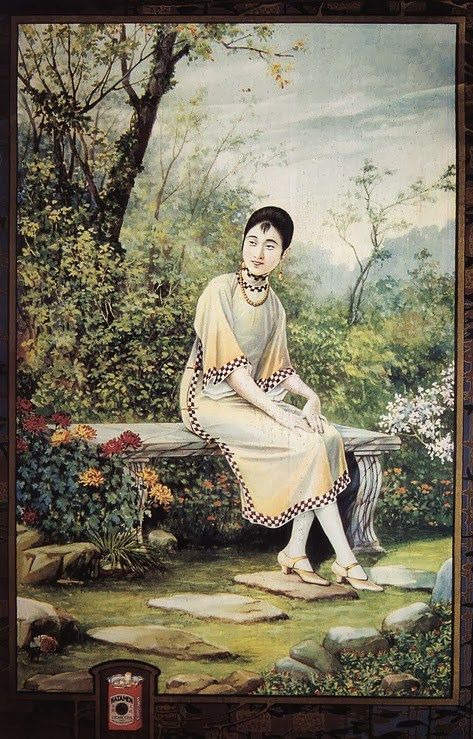
Source: http://www.thepankou.com/history-of-the-qipao-recluse-to-national-dress-1910s-1920s/?epik=dj0yJnU9UU82azlTdzgzSXBiYXV6dzJmUHdQcUFBaXQtci1KQVImcD0wJm49MmZTY3pna3FzQXBVOFJ3bGJSY1laZyZ0PUFBQUFBR0FVVU8w (I’m actually not sure if this is late 20s or early 30s, judging by the baggy look it’s probably 20s but the early 30s one piece dress had a similar, albeit tighter, silhouette)
Another thing about 1920s Chinese fashion is that I rarely see long-sleeved women’s garments, even in images supposedly depicting fall/wintertime. The more common way to fight off cold weather throughout the 1920s and 30s was to wear Western coats, especially Paul Poiret style fur wrap coats. I recall a lady in a contemporary film saying that coat design of this period was dominated by Parisian trends.
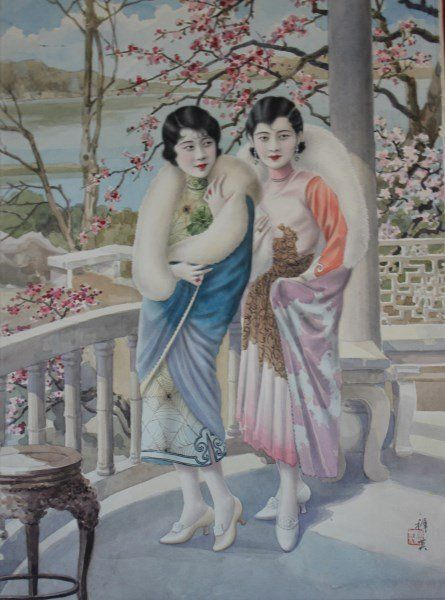
Source: https://www.liveauctioneers.com/item/19256348_hang-zhiying-1899-1947 (late 20s/early 30s) (the lady on the right is finally wearing long sleeves, not so easy to come across haha)
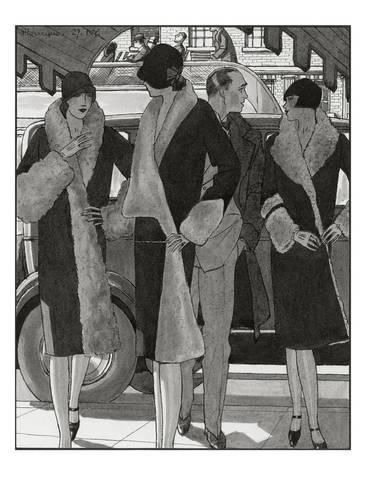
Source: art.com (their website shut down I can’t find the url) (1920s Western fur coats)
Late 20s Chinese womenswear was quite easy to identify. The skirts in aoqun outfits became longer, usually ankle length, with very wide hems. They had a tube like silhouette but were quite full, so I deduce that they were constructed from rectangular panels that were then cartridge pleated or gathered around the waistband. The waistline of the bodice (I don’t think these could be considered separate robes anymore...) rose quite significantly, ending at the natural waist. This was a divergence from the Western silhouette, which remained rectangular until late 1929.
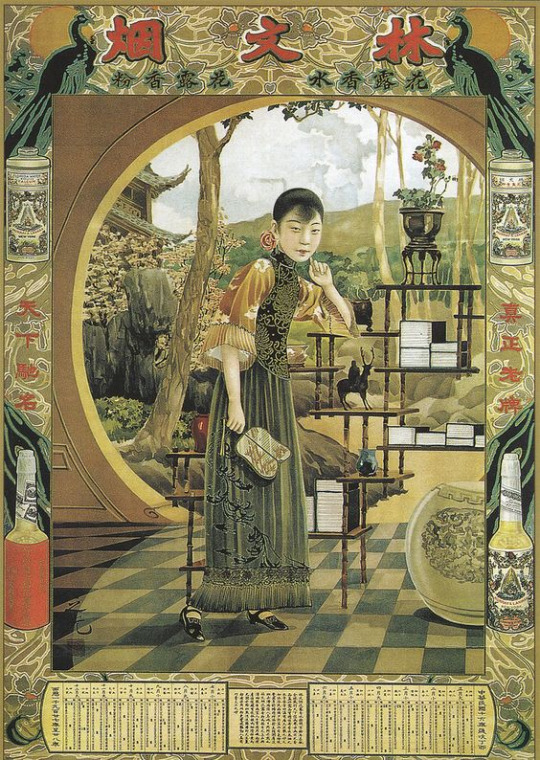
Source: https://www.flickr.com/photos/contumacy-singh/2803160798/in/photostream/?epik=dj0yJnU9cWhFcko0YUU5WXd1OERGQWd2VW9aQ1RXcFZ2S0VUTEEmcD0wJm49bWtmNTUzX0oxY2N3Zl94TWgycU5sZyZ0PUFBQUFBR0FVSW5R (a perfume ad calendar showing the years 1927-1928)
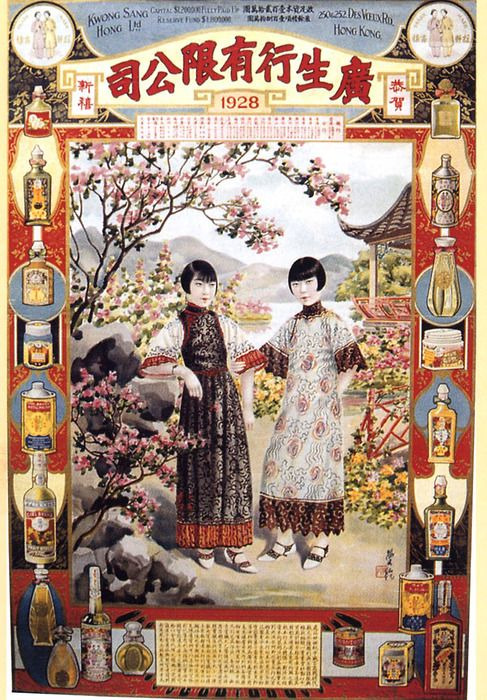
Source: rs.bift.edu.cn (a cosmetics ad from 1928) (this company, Kwong Sang Hong, was founded in the 1890s and was really iconic and produced many advertisements which are great primary sources)
By the end of the 1920s there were four main styles of womenswear: the two piece aoqun with robe and skirt, the three piece set with robe, vest and skirt and the proto-cheongsam one piece dress. These styles coexisted; it was the silhouette (length of skirt, sleeve shape etc.) that changed throughout the decade and these changes applied to all styles. Interestingly, I don’t think I have seen photos of 1920s Chinese women wearing actual Western fashion, which is weird considering the level of westernization in the 20s and how easy to make and accessible 20s Western clothing was, in addition to the fact that many women in neighboring Japan had already adopted Western clothing.
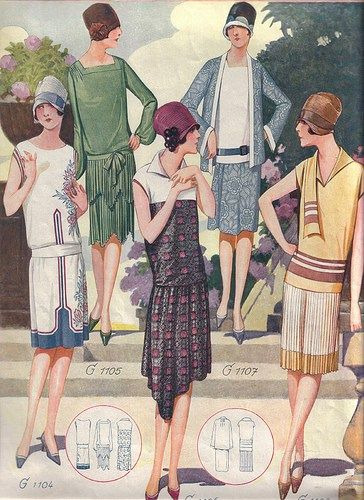
Source: https://simplycirculate.wordpress.com/2012/04/05/beautiful-20s/?epik=dj0yJnU9WFVWLWtXQU9WM3NhOWVPZTJjZXlTMjc5SHVqeVNTUHQmcD0wJm49U1R4b2swZmxzQU9IUWpkX1o5TWVaUSZ0PUFBQUFBR0FWa2Zz (late 20s Western summer fashion) (Isn’t it interesting that when people think of 20s fashion they usually think of late 20s fashion? Early 20s with the long dresses and big hats deserve more appreciation, even though I don’t really like it personally)
Chinese women began wearing Western fashions in very small numbers beginning in the 1900s, but I guess because of the elaborate nature of Edwardian clothing and the lack of corsetry traditions in China it was expensive and not really popular. I have only seen uber-rich Chinese women in portraits wearing Western fashions. If a lady wanted to show Western influences in her fashion sense it was usually by using Western decorations or fabrics to make her Chinese clothes, or by wearing Western accessories.

Source: https://driwancybermuseum.wordpress.com/2012/07/29/semarang-history-collections/amp/?epik=dj0yJnU9TWRsc3pQU05nQTBVa19xVjZzSFBpSzlHclpTUHZrSUQmcD0wJm49WkdreF9VZnZqUEY3RWVOSVBaOExsdyZ0PUFBQUFBR0FVSnlz (Madame Wellington Koo in a 1910s ballgown)
I think it’s of some importance to discuss the methods for pattern drafting and construction. Chinese clothing began to become more form fitting in the late 20s, however it should be noted that this form-fitting shape was not achieved by Western dressmaking methods i.e. shaped pattern pieces and darts/tucks, but rather using the historical Chinese method of pattern drafting 平裁; Western dressmaking techniques would not be commonly used on Chinese garments until the 1950s. With this method, the front and back pieces of a robe/bodice would be two identical T shapes with overlapping parts at the front right closure. Historically (I mean in the Ming Dynasty) the overlapping bits at the front would be cut separately and then attached to the front pieces, resulting in a seam down the center front 中缝 that many people consider to be a staple of hanfu, although I’m not sure if this method was used before or after the Ming Dynasty. Similarly, I’m also not sure if this was the way 1920s/30s bodices were constructed, they may as well have two separate whole front pieces joined to the back piece at the shoulder and underarm/side seams. Until I get my hands on a period original this shall remain a mystery unless someone enlightens me (please). Anyway, bodices constructed in this method are not three dimensional and could be laid flat on a surface; this method was also used in other East Asian countries, maybe you have seen that when kimonos are laid or hung flat they have a T shape as well.
Example: https://www.metmuseum.org/art/collection/search/88086 (mid 20s ao, can’t show the image here unfortunately)
This is getting very long so I will split the 1920s into multiple sections, information on design details, hair and accessories will be in subsequent posts.
#1920s#art deco#chinese history#chinese fashion#historic fashion#expressionism#20th century#abridged history of early 20th century chinese womenswear
283 notes
·
View notes